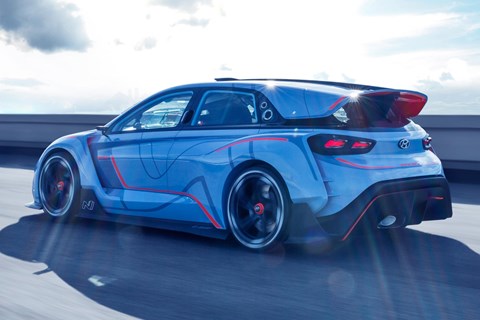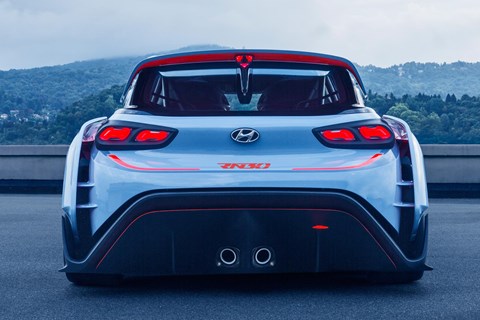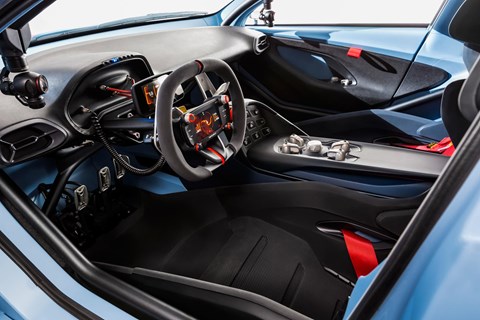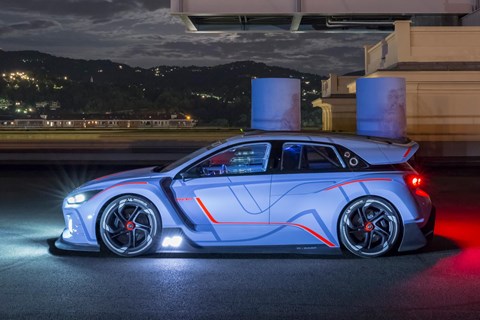► Latest i30 gets racing makeover at 2016 Paris motor show
► N is the name for Hyundai’s new performance sub-brand
► RN30 concept: 375bhp, 333lb ft, AWD and lots of aero
Hyundai has taken a long hard look at itself and decided it’s time to get down the gym; it’s all very well having a bubbly personality and independent means – if you really want to attract customers in 2017, you need to be more than good company and good value; you need a bit of muscle. And this new Hyundai RN30 hot-hatch concept at the 2016 Paris motor show certainly has plenty of that.
Is this all pure fantasy, or is the Hyundai RN30 actually telling us something?
It’s the next step in Hyundai’s journey towards putting its forthcoming N high-performance sub-brand into production – the RN30 concept is based on the latest i30, the car that will eventually spawn the first N hot hatch showroom model in 2017.

But to call the RN30 a mere hot hatch is something of an understatement, as Hyundai has basically built itself a 375bhp, all-wheel-drive racing car that wouldn’t look out of place on the grid of the BTCC.
If looks could kill…
Indeed. From the ludicrously distended ‘floating’ wheelarches – some 30mm wider than the regular i30, making the RN30 1950mm across – to the largest rear roof spoiler we’ve ever seen, complete with central fin element and ‘balanced’ by a truly monstrous diffuser, there’s enough butch here to make the current Civic Type R question its masculinity.
And it isn’t so much slammed as flattened, for despite the 19-inch wheels, the RN30 is no less than 84mm lower than the standard i30 – at just 1355mm at its tallest. The white ceramic exhaust coating is a nice touch.

Instead of turning to your typical CFRP (that’s carbonfibre reinforced polymer) to reduce weight, Hyundai has been working with global chemical company BASF on high-performance plastics – light, durable and environmentally friendly, apparently.
Naturally, it’s also binned everything non-essential for the pursuit of speed, and moved all the heavy stuff as low down as possible to minimise the centre of gravity. This includes the remaining pair of seats, which are lightweight buckets mounted lower and further back in the chassis.

Elsewhere on the inside the rear bench has given way to a rollcage, all the switchgear is bespoke and there’s a pair of gimble-mounted cameras in the A-pillars ‘to capture the driver’s reactions and dynamic moments.’ We suspect ‘the passenger vomiting’ may be more appropriate. Another camera points forwards from the centre fin on the roof.
How much of this can we expect to see on the production i30N?
While the Type R has set a pretty extreme benchmark, we can safely say the outside and inside of the confirmed i30N production model won’t quite be this… compensatory. We’d expect a more conventional front-drive affair to begin with, probably packing less punch than the concept.
A version with around 300bhp, for example, would compete neatly with the likes of the blinked-and-missed-it ninth-gen Civic Type R – and leave room for a more potent model later down the line, if the concept proves popular…

That level of performance potential makes an all-wheel-drive system essential equipment, and the RN30 features e-LSD tech for additional control, while the accompanying twin-clutch paddleshift gearbox of the concept would certainly make the i30N go faster. We’d expect details like electronically controlled exhaust valving to make production, too.
See more from the Paris motor show here